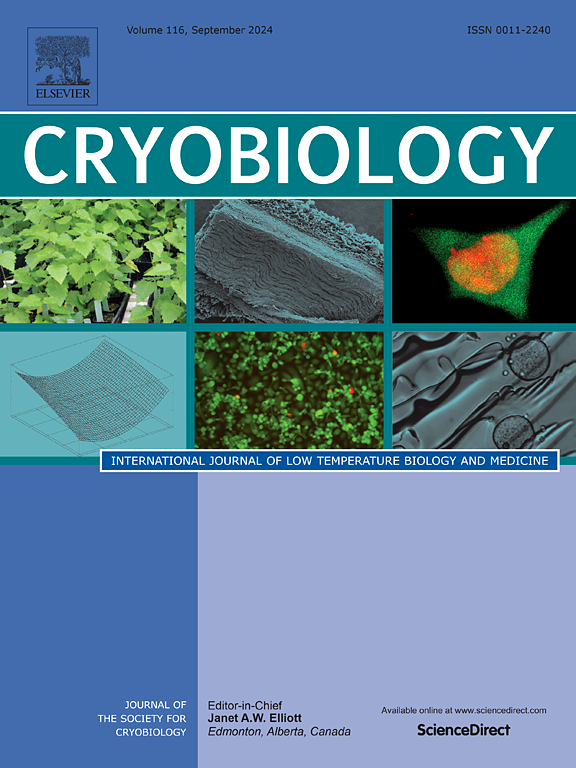不同直径低温探针在支气管低温活检过程中生物热传递的数值模拟
IF 2.1
3区 生物学
Q2 BIOLOGY
引用次数: 0
摘要
使用柔性冷冻探针的经支气管冷冻活检是一种新兴的活检技术。然而,尺寸不合适的冷冻探针或不准确的冷冻时间可能导致组织冷冻损伤或不合格的组织标本。本研究采用数值模拟的方法探讨了不同直径(1.1 mm、1.9 mm、2.4 mm)的低温探针对支气管肿瘤低温活检中组织温度分布和相变的影响。建立了含肿瘤的三维支气管模型。基于Pennes生物热方程和有效热容法,模拟了不同插入深度(0 ~ 1.0 mm,间隔0.1 mm)下低温探针在0 ~ 10 s内的换热过程。通过耦合呼吸气流分析多物理场效应。结果表明,增加低温探针的直径和插入深度会导致组织内低温区域的扩大,从而增加肿瘤周围组织低温损伤的风险。此外,低温探针直径对组织相变的影响比插入深度更显著。增加冷冻探头的直径会减少到邻近肿瘤周围组织的距离,导致肿瘤周围组织内的冷冻区域迅速扩大。相反,插入深度主要影响冻结区的轴向延伸。此外,呼吸气流对温度分布无显著影响。本研究为临床选择冷冻探针参数和优化冷冻时间提供了理论依据,有利于获得足够的组织样本,同时最大限度地减少对健康组织的冷冻损伤。本文章由计算机程序翻译,如有差异,请以英文原文为准。
Numerical simulation of bioheat transfer during bronchial cryobiopsy using cryoprobes of different diameters
Transbronchial cryobiopsy using flexible cryoprobes is an emerging biopsy technique. However, an inappropriately sized cryoprobe or inaccurate freezing time may result in tissue cryoinjury or substandard tissue specimens. This study uses numerical simulation to explore the effects of different diameter cryoprobes (1.1 mm, 1.9 mm, 2.4 mm) on tissue temperature distribution and phase transition in bronchial tumor cryobiopsy. A three-dimensional bronchial model containing tumors is constructed. The heat transfer process of the cryoprobes within 0–10 s at different insertion depths (0–1.0 mm, interval 0.1 mm) is simulated based on Pennes bioheat equation and the effective heat capacity method. Multi-physics effects are analyzed by coupling respiratory airflow. The results demonstrate that increasing the cryoprobe diameter and its insertion depth leads to an expansion of the low-temperature zone within the tissue, thereby elevating the risk of cryoinjury to surrounding peritumoral tissues. Moreover, the effect of cryoprobe diameter on tissue phase transition is more significant than that of insertion depth. Increasing the cryoprobe diameter will reduce the distance to adjacent peritumoral tissues, resulting in rapid expansion of the frozen region within peritumoral tissues. In contrast, the insertion depth primarily influences the axial extension of the frozen region. Additionally, respiratory airflow demonstrates no significant impact on temperature distribution. This study provides a theoretical foundation for the clinical selection of cryoprobe parameters and optimization of freezing duration, facilitating the acquisition of sufficient tissue samples while minimizing cryoinjury to healthy tissues.
求助全文
通过发布文献求助,成功后即可免费获取论文全文。
去求助
来源期刊

Cryobiology
生物-生理学
CiteScore
5.40
自引率
7.40%
发文量
71
审稿时长
56 days
期刊介绍:
Cryobiology: International Journal of Low Temperature Biology and Medicine publishes research articles on all aspects of low temperature biology and medicine.
Research Areas include:
• Cryoprotective additives and their pharmacological actions
• Cryosurgery
• Freeze-drying
• Freezing
• Frost hardiness in plants
• Hibernation
• Hypothermia
• Medical applications of reduced temperature
• Perfusion of organs
• All pertinent methodologies
Cryobiology is the official journal of the Society for Cryobiology.
 求助内容:
求助内容: 应助结果提醒方式:
应助结果提醒方式:


